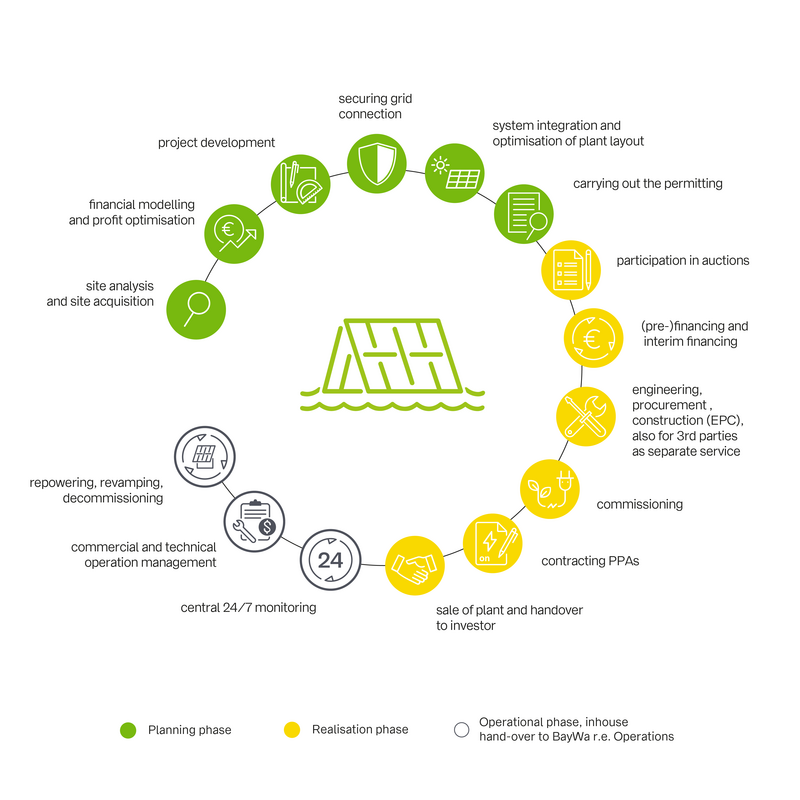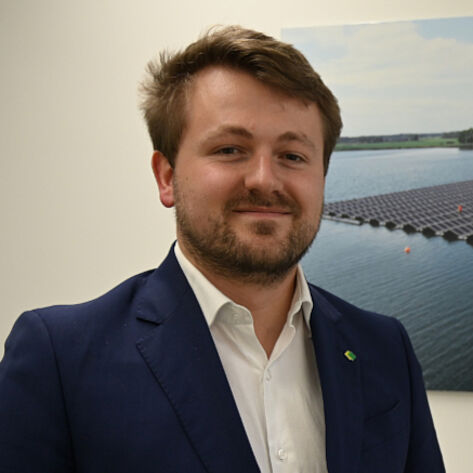Realise your property’s full potential with Floating-PV
Clean energy generators on water
Our floating solar systems help you to profit from your otherwise underused bodies of water, such as coal quarries, mineral extraction pits, hydro dams or drinking water reservoirs.
In countries where water is scarce, Floating-PV modules also significantly reduce evaporation from the water’s surface.
Floating-PV on areas of 50 hectares or more will soon be feasible in southern Europe without subsidies or state funding.
This will help drive the clean energy revolution and diffuse the heated debate on land use in the EU.
Driving the sector forward with investment, technology and new standards in best practice
The Market Leader in Floating-PV
Since bringing our pilot floating solar system online in the Netherlands in 2018, we have gone on to install Floating-PV systems with a total capacity of more than 260 MWp. This gives us a market share of 75 % of all installed floating installations in Europe.
In 2020 we completed the largest Floating-PV system outside of Asia – our Bomhofsplas plant at 27.4 MWp – and then went on to better this with our 29.8 MWp project Uivermeertjes and with our 41.4 MWp project Sellingen in 2021.
Apart from all our 14 Floating-PV installations in the Netherlands, we also realised our first floating solar projects in APAC region in Thailand with 2.8 MWp, in Germany with 3 MWp, and in Austria with 24.5 MWp. The latter being the largest floating solar installation in Central Europe. And this was just the beginning…
Our Floating-PV Initiatives in Numbers
Our quality keeps investments safe for 30 years
Work with the most established and experienced Floating-PV experts in Europe. We offer holistic project specific solutions: from project development, planning, procurement, financing, construction to commissioning and operational management. We also offer turnkey EPC services for third parties.
We’ve developed our own system design, based on the highest-quality components and most outstanding expertise. Our work seamlessly integrates systems both above and below water.
Trust us for in-depth engineering expertise, covering areas like: project-specific design to account for snow and wind loads, sophisticated earthing, protecting against module submergence and anchoring and mooring assessments, with detailed mooring load analysis for each moving line. We’re also proud to have the highest health and safety standards in the market.

Reliability and Safety
We’ve adapted our cutting-edge ground-mounted solar technology for efficient, safe use on water. Our PV systems use our own fully VDE-certified electrical block design, atop long-lasting floating substructures from our partner, Zimmermann PV-Stahlbau. Integrated mooring and anchoring systems ensure stormproof solidity and security.
Our floating system design satisfies all European standards, a mark of long-lasting reliability. You can expect the highest possible yields and effective maintenance throughout all operations.
Environmental Impact and Sustainability
Preserving the environment has always been key to our Floating-PV solution. For a project to be considered a success, it needs to safeguard biodiversity and sustainability.
It has to integrate with the local landscape and provide safety and value for nearby residents. We also pay attention to evaporation, doing our part to fight water scarcity.
Find out more details about our cutting-edge system design

We are proud to be part of this innovative project and are happy that the part of our water surface without sand extraction activities now offers new benefits. This development fits in perfectly with our ambition to be climate neutral by 2030. We look forward to many years of good cooperation with BayWa r.e. as a professional, reliable partner.
Gerard Hoiting
LMB Roelofs BV, owner of Tynaarlo sand pit
Our Activities
Project Development
Project Development
Engineering, Procurement & Construction
Engineering, Procurement & Construction
Project Structure
Project Structure
Operational Management
Operational Management

BayWa r.e. will stay at the forefront in scaling up and expanding to new markets and applications. The promising results from our ecological studies show that Floating-PV is not only profitable, but also a sustainable way to fight climate change.
Michele Tagliapietra
Head of Product Management Floating-PV
Discover our Floating-PV projects across the globe

Netherlands
The Netherlands have been our first active market for Floating-PV. Check out our comprehensive reference list for Floating-PV installations.

APAC
With project UBE in Thailand, we realized our first floating solar installation in the APAC region. Read more in the case study.

Germany
We have built one of Germany’s largest Floating-PV parks for company Quarzwerke.

Austria
24.5 MWp project Grafenwörth of our subsidiary ECOwind in Austria is Central Europe’s largest PV park on a body of water.
Video Gallery





Frequently asked questions about our Floating-PV solution
- How does Floating-PV benefit lake owners?
Floating-PV is a great opportunity to generate extra value from your body of water. You can benefit from long-term lease income on areas that previously only created costs, while at the same time promoting sustainability and renewable energy implementation. You can become the owner of the floating system, either by buying it or by purchasing the generated power. The electricity can be used for your own consumption, enabling you to lower and secure your energy costs for the long term and avoid possible CO2 taxes, or you can sell the electricity on to another company, or to the grid.
Operators of hydroelectric power stations benefit from dual use of the reservoir to maximise energy production. At high solar irradiation, the floating solar park delivers electricity; at low irradiation or at night, the hydro technology delivers electricity. Furthermore, a Floating-PV system will reduce evaporation from reservoirs, and the existing grid connection can be used, which lowers the cost of installation. A real win-win situation.
- What are the benefits of partnering with BayWa r.e.?
With more than 30 years of experience in the field of renewables, and 230 MWp installed of Floating-PV, we draw upon extensive know-how. We are a quality-orientated, full-service provider with a strong financial background and a tight network of suppliers and subcontractors to deliver at high quality and competitive costs. We bring the table technology know-how, development capabilities and EPC (Engineering, Procurement and Construction) ability. Our parent company BayWa AG generates an annual turnover of 17.2 billion euros.
- Does the system impact marine life or birds?
Since beginning of operation of our first projects in the Netherlands, we have been performing studies to monitor and evaluate the impact of our parks on the water ecosystem and on the surroundings, with support and collaboration of independent research institutes and universities. Completed studies and intermediate results show little to no impact on the water ecosystem, while in some cases even promoting bio-diversity of fish and invertebrate species, as shown in our Bomhofsplas biohuts case study. Birds also like to stop on and around our parks, and bird-counting activities have not shown so far a decrease of bird presence in proximity of our parks.
- Is there any impact on water quality?
We have not seen any negative impact on water quality. Qualitative and quantitative studies are currently under way in collaboration with universities to measure and monitor water quality, with promising results. With the optimized floating structure system we use, we allow maximum water movement beneath the system. We expect less algae build-up due to moderate shadows underneath the construction – certain types of algae require substantial light to grow, so a reduction of these varieties might occur, which reduces maintenance costs for cleaning of the water body.
Other varieties thrive in the shade, but we use a specific type of glass/glass modules in our system which ensure good light transparency, so they only cast moderate shadows. We think this creates the ideal conditions for avoiding excessive growth of both kinds of algae.
The components have undergone in-house as well as third parties leaching tests, which confirmed they are also suitable for use in reservoirs intended for drinking water.
- Is it possible to use the water for Floating-PV and other purposes (e.g. recreational use) simultaneously?
For most of our Floating-PV projects we are installing on artificial bodies of water such as decommissioned parts of sand pits, coal mining areas and water storage facilities, which are not used for recreation or tourism. It is in theory possible to allow dual use of bodies of water with productive or recreational activities, but additional measures to avoid interference between the activities and to avoid risks should be taken.
- In which countries is BayWa r.e. installing Floating-PV systems?
We have 15 projects installed at the moment, of which 12 in the Netherlands, 1 in Germany, 1 in Austria and 1 in Thailand, for a total of 230 MWp. We are continually expanding and at the moment we have a secured pipeline of projects in more than 10 countries, between Europe and APAC.
- Is Floating-PV a proven technology?
Floating-PV is not a new technology, only a new application of an existing technology. Our installed Floating-PV systems fulfil all Eurocode standards and are certified by VDE (German Association for Electrical, Electronic & Information Technologies). The system is based on the construction experience of BayWa r.e. – we installed more than 2.6 GWp of PV plants globally. It can be maintained by our BayWa r.e. O&M unit. It ensures investors a smooth operation over the lifetime of the project. Due to our position monitoring, we make sure to always determine the exact location of the Floating-PV system, which further increases the safety.
BayWa r.e. was also part of the Joint Industry Project that led to the publication of the first Recommended Practice for Floating-PV, DNV-RP-0584, and keeps participating in industry-wide activities to increase the safety and reliability of Floating-PV systems.
For those investing in Floating-PV from BayWa r.e., the return, risk and administration are no different than when investing in ground-mounted projects, as all the particulars are handled by our experienced teams.
- How can BayWa r.e. ensure the safety of the system and especially the safety of individuals using the water as a lake for swimming?
Our installed Floating-PV systems fulfil all electrical regulations relating to the installation of electrical systems. We install a perfect grounding system to protect the system from any electrical failures. Our systems are reviewed and certified by the independent company VDE and are compliant with all electrical regulations and standards. Furthermore, we focus on lakes that are not used for recreational purposes.
- Are there any support schemes in place in European countries?
There are plenty of support schemes available in Europe for the development and construction of Floating-PV projects, either in form of feed-in tariffs such as the SDE+ in the Netherlands, or renewable CfD auctions, as well as innovation tenders. The requirements and eligibility of a specific Floating-PV project may vary country by country and even region by region, and they keep changing in time, which is why an experienced partner in the development of Floating-PV such as BayWa r.e. can support in finding the right business case at the right point in time.
- What is the potential for Floating-PV in Europe?
According to a study by the World Bank, there is a potential of 204 GWp in Europe alone, if we use 10% of the man-made inland freshwater reservoirs. (Source: Where Sun Meets Water, Floating Solar Market Report, 2019 International Bank for Reconstruction and Development / The World Bank, page 57, Graph.) Only around 0.15% of this potential has currently been installed, which leaves huge potential for market growth.
Solar Projects

Agri-PV

Services






